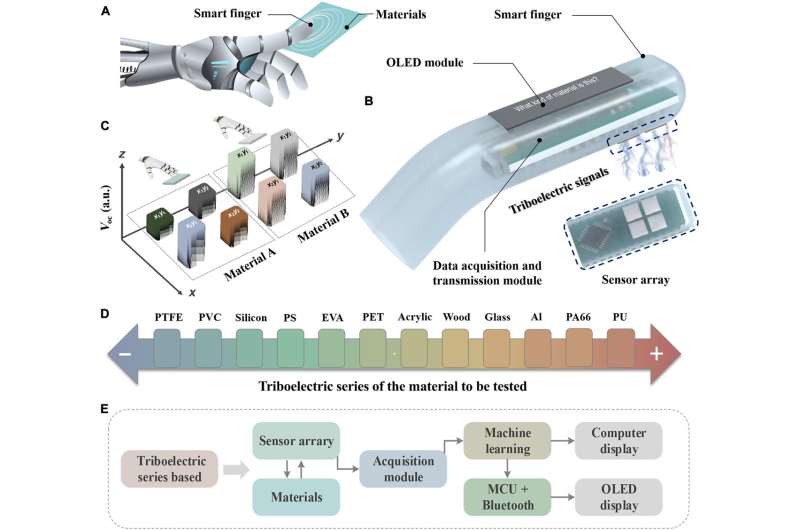
A team of researchers at the Chinese Academy of Sciences, has developed an artificial finger that was able to identify certain surface materials with 90% accuracy. In their paper published in the journal Science Advances, the group describes how they used triboelectric sensors to give their test finger an ability to gain a sense of touch.
Prior research has led to the development of robotic fingers that have the ability to recognize certain attributes of certain surfaces, such as pressure or temperature—the team with this new effort, have taken such efforts further by adding the ability to identify a material that is being touched.
The finger was created by applying small square sensors to the tip of a finger-shaped object. Each of the squares was made of a different kind of plastic polymer, each chosen because of their unique electrical properties. When such sensors are moved close to an object, such as a flat surface, electrons from the sensors interact with the materials in unique ways.
The sensors beneath the polymer were all connected to their own processors inside of the finger, which were then connected together to allow for comparison of results and for machine learning-based data analysis. The researchers also attached a tiny LCD screen for displaying results. The researchers then tested their finger by having it touch various flat surfaces such as those made of glass, wood, plastic and silicon. They found it capable of detecting the right material on average 96.8% of the time, with a minimum accuracy of 90% for all of the surfaces. The researchers also tested the finger for endurance by having it touch a surface thousands of times and found that it held up well enough for industrial applications.
The researchers suggest that if their finger were to be used in an industrial setting it could be connected directly to a control mechanism. They also suggest it could be used to test products to ensure they meet manufacturing standards. And they also note that such a finger could also be used on a full-sized human robot, adding to its capabilities. They point out that the technology behind their finger could likely be used in prosthetic devices to help restore a certain degree of touch for people who have lost such an ability.
Warehouse robots that feel by sight
Xuecheng Qu et al, Artificial tactile perception smart finger for material identification based on triboelectric sensing, Science Advances (2022). DOI: 10.1126/sciadv.abq2521
© 2022 Science X Network
Citation:
Artificial finger able to identify surface material with 90% accuracy (2022, August 8)
retrieved 8 August 2022
from https://techxplore.com/news/2022-08-artificial-finger-surface-material-accuracy.html
This document is subject to copyright. Apart from any fair dealing for the purpose of private study or research, no
part may be reproduced without the written permission. The content is provided for information purposes only.
Stay connected with us on social media platform for instant update click here to join our Twitter, & Facebook
We are now on Telegram. Click here to join our channel (@TechiUpdate) and stay updated with the latest Technology headlines.
For all the latest Technology News Click Here
For the latest news and updates, follow us on Google News.
